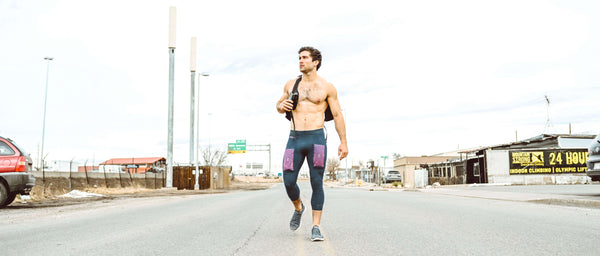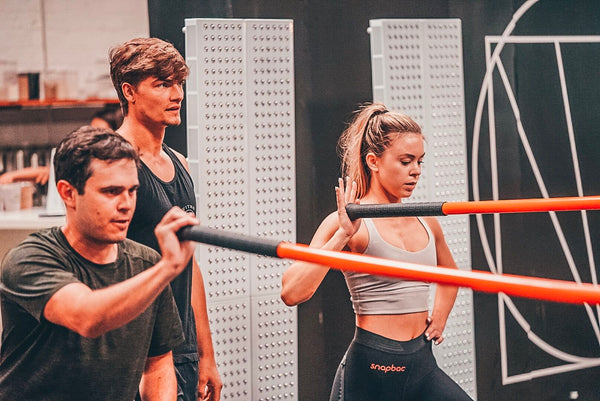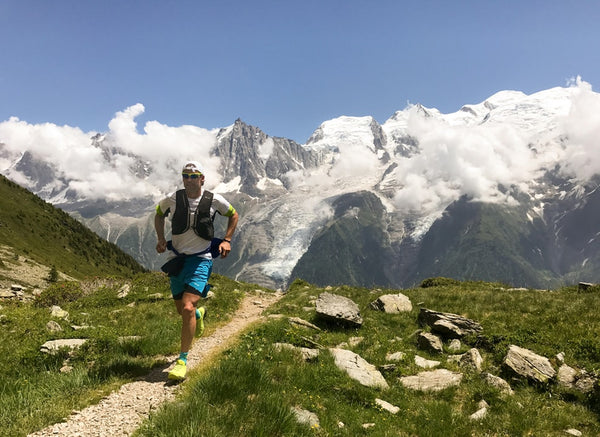Whether dedicated athlete or weekend warrior, we’ve all been taught that working out is a three-part process if we want to get the most from our sweat session and still protect our bodies from wear and tear. We’ve accepted the warm up exercises, workout, and cool down exercises format for every good training routine. Some of us don’t ask why; we just follow the trainer’s advice. Others have a vague idea as to the reasoning behind this structure, but many are actually misinformed with information that has become outdated yet is still passed around at the gym, on the field, and in athletic circles.
We believe the best way to train your body for any sport, competition, or health goal is to know what to do, how to do it, and, yes, why you’re doing it. The ‘why’ may be of little consequence to you, but any professional athlete knows that knowledge in your sport can drive you harder, keep you fitter, reduce your risk of energy, and increase your chances for success. Anyone in health and fitness knows the most overlooked and misunderstood parts of working out are the warm-up exercises and the cool down exercises. The excuse most often given is that there isn’t time, but if you knew the reason behind what you are told to do, you may be more inclined to make the time. That’s why the knowledge we’re about to share can make you a fitter, safer, and healthier athlete.
The Importance of Cool Down Exercises
First, let’s take a look at what science teachers and phys-ed instructors have been telling us for decades. If you’re going to do any aerobic or strenuous exercise, then a cool down is necessary at the end for a minimum of five minutes. This is five minutes of gradually reducing the level of exertion that you’ve been performing at until you can come to a complete stop. So if you’ve been running for the last 40 minutes, drop to a jog, then to a shuffle and finally to a walk to cool down after running. If you’ve been lifting weights, take five minutes to cool down by stretching out the muscles that you’ve been working with. If you play major sports, take five minutes to walk off the energy built-up during the game. The important part of a proper cool down is to steadily drop your intensity in order to bring down your heart rate and breath back to a resting state in a controlled manner.

So why are cool down exercises important?
According to science and research since 2007, they’re not. Well, at least not for the reasons we’ve been taught. One of the first cool down myths is the idea that lactic acid builds up in the muscles and increases exercise induced delayed onset muscle soreness (DOMS). It has long been held that cooling down helps to release that lactic acid thereby reducing muscle soreness. This is false!
This study came from the German physician Otto Fritz Meyerhof who won the 1922 Nobel Prize for Physiology or Medicine when he discovered the conversion of glycogen to lactic acid and back again to glycogen, or the lactic acid cycle. Meyerhof studied the energy changes in frog leg muscles and how they used glycogen as fuel and when treated with a lactic acid solution, it would convert back to glycogen to be used in muscle contractions. He surmised that lactic acid was produced by the breakdown of glycogen when muscles were low on oxygen and then used to fuel the body to continue, and he called the process glycolysis. This built up lactic acid, which really isn’t an acid at all, has long been blamed for muscle fatigue and soreness, but that is not quite right.
Meyerhof’s cycle showed that ‘lactic acid’ was built up in muscles to be used as a subsequent fuel source when starved for oxygen during repetitive movements. Around one quarter of the present lactic acid was oxidized in the muscles to convert into energy which was used to convert the rest of the lactic acid back into glycogen, refueling the muscles completing the glycolysis cycle. This is where many trainers have stopped their research and come to the conclusion that we must go through a cool down to use the lactic acid or otherwise it creates soreness and pain.
Let’s take Meyerhof’s studies into the 21st century. He went on to work with Kurt Lohman who discovered the molecule adenosine triphosphate, or ATP. When carbohydrates breakdown in the body, they store energy in ATP which is then released when the phosphate bonds break during strenuous exertion by muscles or when there is a great demand on the nervous system. When we exercise, we activate the nervous system accessing the fight or flight programming in our bodies. So exercise produces a double impact on phosphate bonds releasing ATP energy.
Putting it all together.
What we know today is that muscles don’t produce lactic acid. They actually produce lactate to release into the body and be used as an energy source for our heart and tissues. Furthermore, lactate actually makes muscles less acidic and acts as an indirect fuel source which in turn delays fatigue. This means lactate leaving the muscles is not what is creating that pain during a workout. It’s actually the breakdown of the phosphate bonds in ATP as it is being used to power the muscle contractions. This breakdown is what creates a build-up of acid. What Meyerhof didn’t quite grasp was that the lactate being excreted by the muscles wasn’t the source of the acid. It was merely the carrier. It removes the acid that was released from the ATP.
So what exactly is lactic acid? Lactate with the addition of a proton creates lactic acid, but in 1977 Wieland Gevers, a South African biochemist, discovered that lactate doesn’t attach to one proton. It actually attaches to a pair of free protons which reduces the acid created from the addition of protons released during exercise all due to the process of ATP usage. What this means to today’s athlete is that there is not a lactate threshold, we do not need to cool down to release it from our muscles and it does not stress the body. Lactate is one of our best tools when we push ourselves to the limit!
Are cool down exercises necessary?
If we don’t need to cool down in order to release lactate, then do we need to cool down at all? There are actually several theories going around on this right now, and more research is needed to be conclusive from all angles. Let’s take a look at the current studies and their findings to determine if you need to spend the extra five minutes during your training.
All soreness is not entirely from the collapse of phosphate bonds. A lot of what you are feeling are the microtears from pushing your muscles past their limits and forcing them to tear and rebuild bigger and stronger. This doesn’t always hold true due to the repeated bout effect. This is your body’s way of learning to adapt. When you constantly do the same athletic workout exercises at the same level, your muscles stop tearing because they have adapted to the intensity in your body’s attempt to avoid damage. To continually build strength and endurance, you will need to constantly change up your reps, weight, speed, distance, and energy output. So does a cool down relieve any of that pain?
No. Studies have concluded that a cool down does nothing to alleviate DOMS. One study analyzed 36 active adults who were put through a series of strenuous forward lunges while holding barbells. The next day they were put through a pain threshold test. The group who cooled down had the same pain points as the control group. Similar studies were preformed with Spain’s professional soccer team with a much more intense exercise series, and the group who cooled down had the same pain as those who didn’t.

Cool Down Benefits.
This latter study did find something else. The soccer players who cooled down were able to were able to perform a vertical leap slightly higher than those who simply sat on the bench after exercise. All other measurements on performance, flexibility, and DOMS were the same. This difference was considered negligible in the study, but for a professional athlete, a slight advantage, a microsecond, can be the only difference you need.
This may not be enough of a reason for you to take five to ten minutes to slow yourself down, but this isn’t the only finding when cool down exercises went under the microscope. The reason we should all take the time is blood pooling and rapid drops in blood pressure. That doesn’t sound pleasant, does it?
When we vigorously exercise, our heart rate and blood pressure increase, at times 400 – 600 percent more than when we are at rest, and our cardiovascular system reroutes our blood away from our abdomen and sends it to our heart, brain, and the extremities that most need it. So if we’re running, the blood is being sent directly to our legs. The arteries in our arms and legs dilate during exercise allowing for greater amounts of blood flow.
As we continue to move, the heart pumps the blood down which forces the blood towards are feet to continue to move back up to the heart. There are no pumps in our legs. So the blood that goes down needs a force to push it back up otherwise it can pool in our legs. This is normally controlled by small valves that run all the way down the veins in the legs. These valves trap the blood in sections of the vein waiting for the next rush of blood to come through and push what is stored back up to the heart. This action keeps it from going back down to our feet.
When we simply stop exercising, our blood vessels relax, blood is rerouted to our abdomen and our blood pressure and heart rate drop. This is most important to trained athletes as your body will drop much faster and to much lower rates and due to regular training, your blood vessels have larger expansion to hold more blood for the strain you’ve put on your bodies. This means large amounts of blood can rapidly pool in the extremities not sending enough to your brain and make you feel dizzy and even faint. For those home fitness trainees, this may not be as much of a risk. It will depend on how hard your workout was for the day, but most often simply walking from the track back to the lockers to the car will be enough. It is rare that anyone would workout and immediately sit down.
As for our weight lifters and bodybuilders, stretching your muscles to cool down after a good pump is important to keep them flexible and prevent injuries over time. You can actually do your cool down individually after each complete pump when the muscles feel tight. This is because they are full of blood and pulling on the connective tissue. At this point, if you gently stretch it out you can expand your connective tissue and fascia actually allowing the muscle to grow bigger and have a better shape. Try to stretch all your major muscle groups, even if you only focused on upper body, and hold the stretch for 10 – 20 seconds. You should not feel any pain, but there may be some discomfort if you are not accustomed to lengthening those muscles.
Cool down exercises in summary.
If a little dizziness, stiff muscles and an increased chance of injury don’t bother you, then cooling down isn’t necessary, but if you are a professional athlete who lives to push your body to the next level and keep yourself a cut above the rest, then a cool down can be the extra edge you need. A cool down feels good too.



